
RUBBER CHEMISTRY AND TECHNOLOGY
Scope & Guideline
Pioneering Research in Polymer Applications
Introduction
Aims and Scopes
- Elastomer Characterization:
Research on the physical and chemical properties of elastomers, including mechanical, thermal, and electrical characteristics, which are essential for understanding material performance. - Rubber Processing Techniques:
Exploration of various processing methods such as vulcanization, mixing, and compounding, aiming to improve the efficiency and quality of rubber products. - Material Reinforcement:
Studies that investigate different fillers and reinforcements, such as carbon black and silica, and their effects on the mechanical properties and durability of rubber compounds. - Sustainable Practices:
Research into sustainable and eco-friendly alternatives in rubber production, including bio-based materials and recycling methods to reduce environmental impact. - Advanced Rubber Applications:
Development of innovative applications for rubber materials, including intelligent tires, self-healing rubbers, and smart elastomers for various industries.
Trending and Emerging
- Nanocomposites and Advanced Fillers:
An increasing number of studies focus on the use of nanomaterials and hybrid fillers in rubber formulations, which enhance mechanical properties and provide new functionalities. - Self-Healing and Smart Elastomers:
Research into self-healing materials and smart elastomers that respond to external stimuli is trending, reflecting the demand for advanced materials in applications such as automotive and medical devices. - Sustainable and Green Chemistry:
There is a growing emphasis on sustainable practices in rubber technology, including the use of bio-based additives and environmentally friendly processing methods that align with global sustainability goals. - Data-Driven Approaches:
The integration of data-driven methodologies, including machine learning and artificial intelligence, is emerging as a significant trend for optimizing rubber formulations and processing techniques. - Advanced Characterization Techniques:
The application of sophisticated characterization methods, such as X-ray tomography and advanced microscopy, is on the rise, providing deeper insights into material properties and behaviors.
Declining or Waning
- Traditional Rubber Compounding:
There has been a noticeable decline in studies focused solely on traditional rubber compounding techniques without integration of modern technologies, as researchers are now more inclined to explore innovative methods. - Basic Physical Property Studies:
Research concentrating on basic physical properties of rubber, such as simple tensile strength tests, has decreased as more complex analyses and modeling approaches gain prominence. - Conventional Crosslinking Methods:
The exploration of conventional sulfur-based crosslinking methods is waning, with a shift towards investigating alternative curing agents and methods that offer better performance and sustainability.
Similar Journals

KGK-Kautschuk Gummi Kunststoffe
Fostering Collaboration in Rubber and Plastics ResearchKGK-Kautschuk Gummi Kunststoffe is a prominent journal dedicated to the fields of industrial and manufacturing engineering, materials chemistry, mechanical engineering, and polymers and plastics. Published by DR ALFRED HUTHIG VERLAG GMBH in Germany, this journal has established itself as a vital resource for researchers and professionals involved in the rubber, elastomers, and polymer industries since its inception in 1978. With an emphasis on contemporary advancements and emerging technologies, the journal aims to disseminate cutting-edge research and developments in the understanding of material properties, processing techniques, and applications. While the journal is categorized in the Q4 quartile across multiple disciplines in 2023, it still plays a crucial role in bridging the gap between theory and practical innovation. Researchers, professionals, and students alike are encouraged to contribute to and engage with the latest insights in this dynamic field, fostering collaboration and knowledge sharing to advance applications in industry and academia.

Composites Part C: Open Access
Pioneering Research in Materials ScienceComposites Part C: Open Access, an esteemed journal published by Elsevier, is at the forefront of research in the fields of Ceramics and Composites, Mechanical Engineering, and Mechanics of Materials. Launched in 2020, this fully open-access journal facilitates unparalleled access to significant advancements in composite materials, ensuring that research findings are disseminated widely and freely throughout the global academic community. With an impressive Q1 ranking across multiple related categories and robust placements in Scopus rankings, specifically #78 in Mechanical Engineering and #24 in Materials Science, the journal serves as a vital platform for researchers, professionals, and students to publish their work and engage with cutting-edge studies. It aims to foster innovation and collaboration in the development and application of composite materials and their technologies, making it an indispensable resource for anyone invested in these dynamic fields.

Journal of Metals Materials and Minerals
Connecting Researchers in Metals and Materials EngineeringJournal of Metals Materials and Minerals (ISSN: 0857-6149) is a renowned academic publication dedicated to the interdisciplinary fields of metallurgical science, materials engineering, and mineralogy. Published by Chulalongkorn University, Metallurgy & Materials Science Research Institute in Thailand, this journal serves as a pivotal platform for researchers to disseminate their findings and explore innovative applications related to metals, ceramics, polymers, and biomaterials. Although the journal does not currently adopt an open-access model, it provides insightful content that facilitates knowledge sharing among professionals and academics alike. The journal has established its credibility with impressive Scopus ranking percentiles, particularly in categories such as Metals and Alloys and Ceramics and Composites. With an emphasis on advancing the understanding of materials science from 2017 to 2024, the Journal of Metals Materials and Minerals remains an essential resource for those striving to contribute to and stay informed about the latest trends and breakthroughs in these dynamic fields.
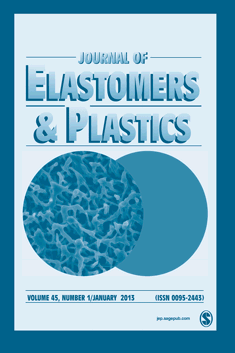
JOURNAL OF ELASTOMERS AND PLASTICS
Exploring the Future of Polymers and PlasticsJOURNAL OF ELASTOMERS AND PLASTICS is a prestigious peer-reviewed journal published by SAGE Publications Ltd that has been at the forefront of material science research since its inception in 1969. Focusing on the fields of Materials Chemistry and Polymers and Plastics, this journal aims to disseminate cutting-edge research that explores the synthesis, characterization, and application of elastomers and plastics in various industries. With a position in the Q2 category for both Materials Chemistry and Polymers and Plastics as of 2023, it showcases significant contributions that push the boundaries of knowledge in these vital areas. Although it does not offer Open Access options, the journal continues to be regarded for its rigorous standards and comprehensive peer-review process. Researchers, professionals, and students in the field will find valuable insights and essential methodologies that can drive innovation and enhance practical applications in elastomers and plastics.
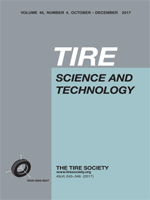
Tire Science and Technology
Advancing Knowledge in Automotive EngineeringTire Science and Technology, published by the TIRE SOC INC, is a pivotal journal in the realm of automotive engineering, mechanics of materials, and polymers and plastics. Since its inception in 1973, the journal has facilitated the dissemination of vital research, serving as a critical platform for academics, industry professionals, and students interested in tire technology and related materials science. The journal has established itself within the Q3 category across multiple fields, as noted in the 2023 rankings, and boasts competitive Scopus ranks, with automotive engineering ranking 65th out of 125. While it currently does not offer open access options, the journal remains an essential resource for high-quality research articles that advance our understanding of tire performance and innovation. With a commitment to enhancing the scientific discourse in this specialized area, Tire Science and Technology is indispensable for anyone seeking to contribute to or expand their knowledge in tire technologies.
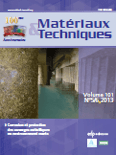
Materiaux & Techniques
Bridging Theory and Application in Material TechnologiesMateriaux & Techniques, published by EDP SCIENCES S A, is a prominent journal in the field of materials science, specifically focusing on diverse and innovative techniques in material development and application. With an ISSN of 0032-6895 and an E-ISSN of 1778-3771, this French journal serves as a key resource for researchers and professionals looking to advance their knowledge and share their findings within the community. The journal holds a Q3 ranking in Materials Science (miscellaneous), indicating its role in contributing to various facets of material science research amidst a growing field. Despite operating under a traditional access model, it provides a platform for rigorous peer-reviewed studies and significant advancements in material technology. With a publication history tracing back to the late 1970s and extending through to 2024, Materiaux & Techniques continues to uphold its commitment to fostering high-quality discourse and innovation in materials science.
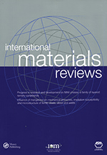
INTERNATIONAL MATERIALS REVIEWS
Exploring the Frontiers of Materials ScienceINTERNATIONAL MATERIALS REVIEWS, published by SAGE Publications Inc, is a leading journal dedicated to the comprehensive analysis of contemporary research in the fields of materials chemistry, mechanical engineering, mechanics of materials, and the study of metals and alloys. With an impressive impact factor and a Q1 ranking across multiple categories such as Materials Chemistry and Mechanical Engineering in 2023, it ranks amongst the top journals for innovative materials research. The journal has a long-standing history since its inception in 1987 and continues to serve as a crucial resource for academics and professionals alike. Although it is not open access, it is renowned for its rigorous peer-review process and its commitment to disseminating high-quality materials science research globally. Researchers, students, and industry professionals benefit greatly from the journal's insightful reviews, both for the advancement of theoretical knowledge and practical applications within the fast-evolving materials field.
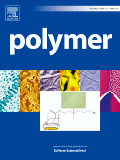
POLYMER
Exploring Innovations in Materials ChemistryPOLYMER, an esteemed journal published by Elsevier Science Ltd, stands at the forefront of polymer science, presenting cutting-edge research that encompasses the realms of Materials Chemistry, Organic Chemistry, and Polymers and Plastics. With a remarkable impact factor reflecting its significance in the academic community, POLYMER has been a vital resource since its inception in 1960, contributing to a converged body of knowledge through to 2024. Rated Q1 in all relevant categories as of 2023, and boasting impressive Scopus rankings, this journal not only facilitates advanced discussions in polymer synthesis, characterization, and applications but also serves as a critical platform for collaborative research among scholars, professionals, and students. While it offers content primarily via subscription, POLYMER remains dedicated to fostering innovation and excellence in the field, making it an essential read for anyone passionate about polymer science.
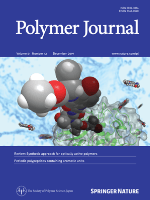
POLYMER JOURNAL
Innovating Materials Chemistry for a Sustainable FuturePOLYMER JOURNAL, published by SpringerNature in the United Kingdom, is a premier academic platform dedicated to the field of polymer science. Since its inception in 1971, this journal has become an essential resource for researchers and professionals interested in the latest advancements in materials chemistry, polymers, and plastics. With its robust H-index and a consistent ranking in the top quartiles of its categories—Q2 in both Materials Chemistry and Polymers and Plastics—POLYMER JOURNAL demonstrates a strong impact in the scientific community. It holds significant recognition in Scopus rankings, occupying the 68th percentile in Materials Chemistry and the 67th percentile in Polymers and Plastics. The journal's commitment to publishing high-quality research articles enables it to serve as a key reference point for innovative studies, theoretical developments, and practical applications in polymer science. Although it is not an open-access journal, researchers and students gain valuable insights through its extensive archives and rigorous peer-reviewed content, making POLYMER JOURNAL a vital source of knowledge for anyone engaged in this dynamic field.

POLYMER BULLETIN
Unveiling Innovations in Polymer ResearchPOLYMER BULLETIN is a prominent journal in the field of polymer science, published by SPRINGER in Germany. Established in 1978, this peer-reviewed journal focuses on the latest research and developments in polymer chemistry, materials science, and condensed matter physics, boasting a commendable impact factor indicative of its rigorous academic standards. With a Q2 ranking in multiple categories including Chemistry (Miscellaneous), Condensed Matter Physics, Materials Chemistry, and Polymers and Plastics, POLYMER BULLETIN serves as an essential resource for researchers, professionals, and students aiming to stay abreast of innovative findings and methodologies within these interdisciplinary landscapes. Although the journal does not currently offer open access, it provides invaluable insights and data that significantly contribute to the advancement of polymer science. For more information and to access published articles, visit the journal's page on the Springer website.